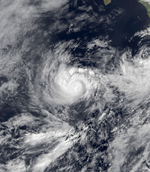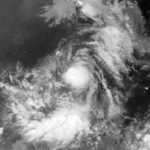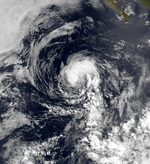1980 Pacific hurricane season
| 1980 Pacific hurricane season | |
|---|---|

Season summary map
|
|
| Seasonal boundaries | |
| First system formed | April 4, 1980 |
| Last system dissipated | October 29, 1980 |
| Strongest storm | |
| Name | Kay |
| • Maximum winds | 140 mph (220 km/h) (1-minute sustained) |
| Seasonal statistics | |
| Total depressions | 16 |
| Total storms | 15 |
| Hurricanes | 7 |
| Major hurricanes (Cat. 3+) |
3 |
| Total fatalities | 0 |
| Total damage | Unknown |
| Related articles | |
| Tropical storm (SSHWS) | |
| Duration | April 4 – April 9 |
|---|---|
| Peak intensity | 50 mph (85 km/h) (1-min) |
| Category 3 hurricane (SSHWS) | |
| Duration | June 9 – June 15 |
|---|---|
| Peak intensity | 115 mph (185 km/h) (1-min) |
| Tropical storm (SSHWS) | |
| Duration | June 16 – June 19 |
|---|---|
| Peak intensity | 60 mph (95 km/h) (1-min) |
| Tropical depression (SSHWS) | |
| Duration | June 17 – June 19 |
|---|---|
| Peak intensity | 35 mph (55 km/h) (1-min) |
| Category 1 hurricane (SSHWS) | |
| Duration | June 25 – June 29 |
|---|---|
| Peak intensity | 75 mph (120 km/h) (1-min) |
| Tropical storm (SSHWS) | |
| Duration | July 1 – July 3 |
|---|---|
| Peak intensity | 50 mph (85 km/h) (1-min) |
| Tropical storm (SSHWS) | |
| Duration | July 12 – July 13 |
|---|---|
| Peak intensity | 45 mph (75 km/h) (1-min) |
| Tropical storm (SSHWS) | |
| Duration | July 18 – July 22 |
|---|---|
| Peak intensity | 50 mph (85 km/h) (1-min) |
| Category 1 hurricane (SSHWS) | |
| Duration | July 28 – July 31 |
|---|---|
| Peak intensity | 75 mph (120 km/h) (1-min) |
The 1980 Pacific hurricane season officially started May 15, 1980, in the eastern Pacific and June 1, 1980, in the central Pacific, lasting until November 30, 1980. These dates conventionally delimit the period of each year when most tropical cyclones form in the northeastern and central Pacific Ocean. This season was relatively uneventful; since no tropical cyclones made landfall, there were no reports of casualties or damage.
Overall, the 1980 season was slightly below the long-term average, with 16 tropical cyclones forming. Of those, 15 were named, 7 reached hurricane intensity, and only 3 became major hurricanes by attaining category 3 status or higher on the Saffir-Simpson Hurricane Scale. All eastern Pacific systems this year formed in the eastern Pacific proper and two storms crossed into the central Pacific: Carmen from the west and Kay from the east. The season had an early start when Carmen crossed over the International Dateline in April. The strongest storm of this season is Hurricane Kay, peaking at 140 mph (225 km/h). Kay lasted for fourteen and a half days, which was the fifth-longest lasting Pacific hurricane at the time.
The 1980 Pacific hurricane season began on April 5, 1980, with the crossing of the dateline by Tropical Storm Carmen and ended with the dissipation of Tropical Depression Newton on October 29. Of the sixteen tropical cyclones that in the eastern north Pacific Ocean during 1980, one was a tropical depression, eight were tropical storms, and seven were hurricanes, of which three were major hurricanes of Category or higher on the Saffir-Simpson Hurricane Scale. Of these systems, all except one tropical storm formed east of 140°W in the eastern Pacific proper. These totals are below the long term average of fifteen tropical storms, nine hurricanes, and four major hurricanes. Two tropical cyclones existed in the central Pacific, both of which crossed in from other tropical cyclone basins. This total is below the average of four or five tropical cyclones per year.
On April 4, a tropical depression formed just east of the International Date Line. At the time, the Joint Typhoon Warning Center (JTWC) designated it tropical depression 02W. As it moved generally northwestwards, it strengthened into a tropical storm just before crossing the dateline, but only received a name in the northwest Pacific, being designated Carmen. After peaking with maximum sustained winds of 70 mph (110 km/h) on April 6. Carmen recurved northeast and crossed the International Date Line, entering the central Pacific on April 7. The JTWC subsequently relinquished responsibility to the Central Pacific Hurricane Center. Carmen lost its initial motion and stalled in the area, ultimately weakening in to a tropical depression on April 8. The depression dissipated the following day and the remnant low returned to western Pacific.
...
Wikipedia

















